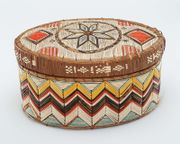Difference between revisions of "Chrysotoluidine"
Jump to navigation
Jump to search
m (Text replace - "== Authority ==" to "== Sources Checked for Data in Record ==") |
|||
| Line 1: | Line 1: | ||
| + | [[File:MFA1973161 Aniline.jpg|thumb|Mi'kmaq basket<br>1973.161]] | ||
== Description == | == Description == | ||
| Line 7: | Line 8: | ||
aniline yellow; yellow magenta | aniline yellow; yellow magenta | ||
| − | == | + | == Physical and Chemical Properties == |
Soluble in ethanol, ether and benzene. Slightly soluble in boiling water. | Soluble in ethanol, ether and benzene. Slightly soluble in boiling water. | ||
| Line 17: | Line 18: | ||
|} | |} | ||
| − | == | + | == Resources and Citations == |
* F. Crace-Calvert, ''Dyeing and Calico Printing'', Palmer & Howe, London, 1876 | * F. Crace-Calvert, ''Dyeing and Calico Printing'', Palmer & Howe, London, 1876 | ||
Latest revision as of 12:36, 30 October 2020
Description
A yellow amorphous powder that dyes Wool and Silk a deep yellow color. Chrysotoluidine was discovered in 1866 by Girard and Chapoteaut. It readily oxides to form a red color.
Synonyms and Related Terms
aniline yellow; yellow magenta
Physical and Chemical Properties
Soluble in ethanol, ether and benzene. Slightly soluble in boiling water.
| Composition | C21H21N3 |
|---|
Resources and Citations
- F. Crace-Calvert, Dyeing and Calico Printing, Palmer & Howe, London, 1876
